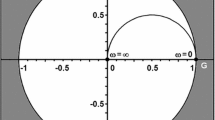Abstract
We address the problem of counting emitted photons in two-photon laser scanning microscopy. Following a laser pulse, photons are emitted after exponentially distributed waiting times. Modeling the counting process is of interest because photon detectors have a dead period after a photon is detected that leads to an underestimate of the count of emitted photons. We describe a model which has a Poisson \((\alpha )\) number N of photons emitted, and a dead period \(\Delta \) that is standardized by the fluorescence time constant \(\tau (\delta = \Delta /\tau )\), and an observed count D. The estimate of \(\alpha \) determines the intensity of a single pixel in an image. We first derive the distribution of D and study its properties. We then use it to estimate \(\alpha \) and \(\delta \) simultaneously by maximum likelihood. We show that our results improve the signal-to-noise ratio, hence the quality of actual images.






Similar content being viewed by others
References
Bentley, D.L.: A contribution to counter theory. J. R. Stat. Soc. B 25, 169–178 (1963)
Cox, D.R., Hinkley, D.V.: Theoretical Statistics. Chapman and Hall, Boca Raton (1979)
Daley, D.J., Vere-Jones, D.: An Introduction to the Theory of Point Processes. Springer, Berlin (1988)
Denk, W., Strickler, J.H., Webb, W.W.: Two-photon laser scanning fluorescence microscopy. Science 248, 73–76 (1990)
Driscoll, J.D., Shih, A.Y., Iyengar, S., Field, J.J., White, G.A., Squier, J.A., Cauwenberghs, G., Kleinfeld, D.: Photon counting, censor corrections, and lifetime imaging for improved detection in two-photon microscopy. J. Neurophysiol. 105, 3106–3113 (2011)
Feller, W.: On probability problems in the theory of counters. Courant Anniv Vol Intersci 8, 105–115 (1948)
Helmchen, F., Denk, W.: Deep tissue two-photon microscopy. Nat. Methods 2, 932–940 (2005)
Isbaner, S., Karedla, N., Ruhlandt, D., Stein, S.C., Chizhik, A., Gregor, I., Enderlein, J.: Dead-time correction of fluoresence lifetime measurements and fluoresence lifetime imaging. Opt. Express 24, 9429–9445 (2016)
Kao, E.P.C., Marion, S.S.: On renewal processes relating to counter models: the case of phase-type interarrival times. J. Appl. Probab. 30, 175–183 (1993)
Lakowicz, J.R.: Emerging applications of fluorescence spectroscopy to cellular imaging: lifetime imaging, metal-ligand probes, multi-photon excitation and light quenching. Scanning Microsc. Suppl. 10, 213–224 (1996)
McLachlan, G.J., Krishnan, T.: The EM Algorithm and Extensions. Wiley, Hoboken (1997)
Oheim, M., Michael, D.J., Geisbauer, M., Madsen, D., Chow, R.H.: Principles of two-photon excitation fluorescence microscopy and other nonlinear imaging approaches. Adv. Drug Deliv. Rev. 58, 788–808 (2006)
Pyke, R.: On renewal processes related to type I and type II counter models. Ann. Math. Stat. 29, 737–754 (1958)
Simsek B.: Applications of point process models to imaging and biology. PhD Dissertation, Statistics Department, University of Pittsburgh (2016)
So, P.T., Dong, C.Y., Masters, B.R., Berland, K.M.: Two-photon excitation fluorescence microscopy. Annu. Rev. Biomed. Eng. 2, 399–429 (2000)
Svoboda, K., Yasuda, R.: Principles of two-photon excitation microscopy and its applications to neuroscience. Neuron 50, 823–839 (2006)
Takács, L.: On a probability problem arising in the theory of counters. Proc. Camb. Philos. Soc. 52, 488–498 (1956)
Tsai, P.S., Kleinfeld, D.: In vivo two-photon laser scanning microscopy with concurrent plasma-mediated ablation: principles and hardware realization. In: Frostig, R.D. (ed.) In Vivo Optical Imaging of Brain Function, 2nd edn, pp. 59–115. CRC Press, Boca Raton (2009)
Yu, D.F., Fessler, J.A.: Mean and variance of single photon counting with dead time. Phys. Med. Biol. 45, 2043–2056 (2000)
Acknowledgements
We thank David Kleinfeld for his guidance on the physics background, especially in contrasting our work with those of Isbaner and his colleagues. We thank David Kleinfeld and Philbert Tsai (UC San Diego) for generating the imaging data. We also thank the reviewers for their helpful comments. Dr. Simsek was supported by an Andrew Mellon Predoctoral Fellowship at the University of Pittsburgh.
Author information
Authors and Affiliations
Corresponding author
Appendix: Proofs
Appendix: Proofs
Proof of Lemma 1: Suppose that \(d = 2c\) is even; we omit the details for the case of odd d, which are similar. To have a concise presentation, let \(\theta = e^{-\delta }\) so that \(A_{k}= A_{k}(\theta )\), and equation (1) becomes
Multiply both sides of (5) by the least common denominator
to get the polynomials \(\{f_{i}: 1 \le i \le d+1\}\) in the first column of Table 1. The cumulative sums \(F_{3} = f_{1}+f_{2}\) and \(\{F_{k} = F_{k-1} + f_{k-1}: 4 \le k \le d\}\) are in the second column there. Using the fact that for \(i < j\), \(A_{i} - A_{j} = -\theta ^{i} A_{j-i}\), we start with
the other cumulative sums given in Table 1 follow similarly, ending with the \(F_{d+1} = -f_{d+1}\) term.
Proof of Theorem 1: Define the functions
and note that
Thus, in equation (2), integrate out \(t_{d}\) to get
Next, integrate out \(t_{d-1}\) in (2) to get
The last expression is obtained by using Lemma 1, to combine the coefficients of the \(U_{1}\) terms. Next, integrate out \(t_{d-2}\) down to \(t_{2}\) — each time applying Lemma 1 — to get
Finally, integrate out \(t_{1}\) to get
Proof of Corollary 1: First we define the vectors \(\varvec{p}_{d} = (p_{0},\ldots ,p_{d})'\) and \(\varvec{\zeta }_{d} = (\zeta _{0},\ldots ,\zeta _{d})'\). We can restate the result in Theorem 1 as
and the result in the Corollary as
thus, we must show that \(Q_{d}R_{d}=I\). Note that for \(0 \le a,b \le d\),
and
Therefore, their product \(S_{d} = (s_{ab})\), where
By inspection, \(s_{ab} =0\) for \(b >a\), and \(s_{aa}=1\). Next, let \(j=k-b\) in this expression and use Lemma 1 with \(d=a-b\) to get \(s_{ab} = 0\) for \(b<a\).
Rights and permissions
About this article
Cite this article
Simsek, B., Iyengar, S. On the Distribution of Photon Counts with Censoring in Two-Photon Laser Scanning Microscopy. J Math Imaging Vis 58, 47–56 (2017). https://doi.org/10.1007/s10851-016-0690-4
Received:
Accepted:
Published:
Issue Date:
DOI: https://doi.org/10.1007/s10851-016-0690-4
Keywords
- Counter
- Dead period
- Exponential waiting times
- Grouping
- Inhomogeneous Poisson process
- Loss of information
- Maximum likelihood




